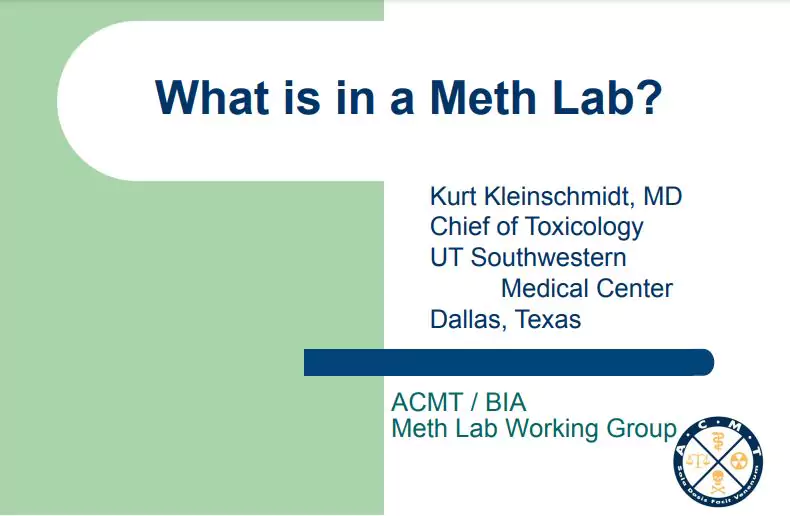‘Cold Cook Methods: An Ethnographic Exploration on the Myths of Methamphetamine Production’ PDF Quick download link is given at the bottom of this article. You can see the PDF demo, size of the PDF, page numbers, and direct download Free PDF of ‘The Making Methamphetamine Possible Cold Cook Meth Bottles Pop Up’ using the download button.
Cold Cook Methods An Ethnographic Exploration PDF Free Download

Making Methamphetamine
I explained the general theory behind this reaction in Chapter Two. Now, after doing the reactions described in the previous two chapters, the Underground chemist has phenylacetone and N methyl formamide suitable for making methamphetamine.
He will want to get going before the chemicals get stale. The first thing he does is test the chemicals.
He puts 5 ml of phenylacetone and 10 ml of N methyl formamide in a clean dry test tube or similar small glass container.
Within a few seconds, they should mix together entirely. At this point, he may offer a prayer to the chemical god, praising his limitless chemical power and asking that some of this power be allowed to flow through him, the god’s High Priest.
He may also ask to be delivered from the red tar that can be the result of this reaction.
If they do not mix, there is water in the N-methyl formamide. In this case, he must distill it again, being more careful this time.
Having tested the chemicals, he is ready to proceed with the batch. (However, if the underground chemist was reckless enough to obtain N-methyl formamide ready-made, he will have to distill it under a vacuum before it can be used in this reaction.)
The phenylacetone he made (about 1 00 ml) is mixed with the N- methyl formamide.
The best amount of N-methyl formamide to use is about 250 ml, but any amount from 200 to 300 ml will work fine.
With 200 ml of N-dimethylformamide, there are about four molecules of N-dimethylformamide to one of phenylacetone.
This is the bare minimum. With 300 m! the ratio is nearly six to one. Any more than this is a waste of N-dimethylformamide.
The best flask for mixing them is a 500 ml round bottom flask.
After they are mixed, this flask is set up as shown in Figure 1 9. The task is sitting in an oil bath, to supply even heating to the flask.
The oil (once again, Wesson is a good choice) should extend about 2/3 of the way up the side of the flask. A metal bowl makes a good container for this oil bath.
This is better than a pan because it will be important to see into the flask. The fact that the oil will expand when heated is kept in mind when filling the bowl with oil.
A thermometer is also needed in the oil bath to follow its temperature. The test material is added to the flask.
The heat source to the flask is turned on. A low heat setting is used so that the rise in temperature can be closely controlled.
The thermometer used in the distillations is placed (clean and dry) inside the flask. The rise in temperature of both the oil bath and the flask is monitored.
The contents of the Flask are stirred regularly with the thermometer.
The temperature of the oil bath is brought to 1 00° C over the course of about 45 minutes.
Once it reaches this level, the heat is turned back down a little bit to stabilize it in this area.
The chemist must closely control every degree of temperature increase from here on. The temperature of the contents of the flask is worked up to 1 05° C.
The contents of the flask are stirred every 15 minutes. At about 1 05° C, the reaction kicks in, although sometimes the heat must go as high as 1 1 0°C before it starts.
When the reaction starts, the contents of the flask begin to bubble, sort of like beer, except that a head does not develop.
A trick to get this reaction going at a nice low temperature is to gently scrape the thermometer along the bottom of the flask.
Although I have never had the sophisticated equipment to prove it, it is a pet theory of mine that this is because ultrasonic waves are generated, producing a condition of resonance with the reactants that causes the reaction to start.
The chemist wants to keep the temperature down at the same level at which the reaction first kicked in for as long as the reaction will continue at that level.
Generally, it can go for a couple of hours at this level before the reaction dies down and an increase in temperature is necessary.
The reaction mixture has the same color as beer and gently bubbles.
The bubbles rise up from the bottom of the flask, come to the surface, and then head for where the thermometer breaks the surface.
Here they collect to form bubbles about 1 centimeter in size before they break.
This may look like boiling, but it is not. Everything inside the flask has a much higher boiling point than the temperatures being used.
These are actually bubbles of carbon dioxide gas being formed as byproducts of the reaction.
The chemist can tell how well the reaction is going by the amount of bubbling going on.
When the rate of bubbling slows down to almost stopping, it is time to raise the temperature. It should only be raised about 3° C. This requires turning up the heat only slightly.
The highest yield of product is obtained when the lowest possible temperature is used.
For the duration of the reaction, the contents of the flask are stirred with the thermometer every half hour.
And so the reaction continued. As the reaction dies down at one temperature setting, the temperature is raised a few degrees to get it going again. It will be able to stay in the 1 20° to 1 300 C range for a long time.
The reaction has a lot of staying power in this range. Finally, after 24 to 36 hours, 1 400 or 1 450 C is reached. The reaction stops.
The chemist takes his time working up to this temperature because the amount and quality of the product depend on it.
Once 1 40° to 1 450 C is reached and the reaction stops, the heat is turned off and the contents are allowed to cool down.
It should still look like beer. A reddish tint means that his prayer failed and he was not delivered from the tar. Even so, there’s still lots of good products in it.
| Author | – |
| Language | English |
| No. of Pages | 44 |
| PDF Size | 10 MB |
| Category | Education |
| Source/Credits | acmt.net |
Cold Cook Methods PDF Free Download
